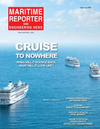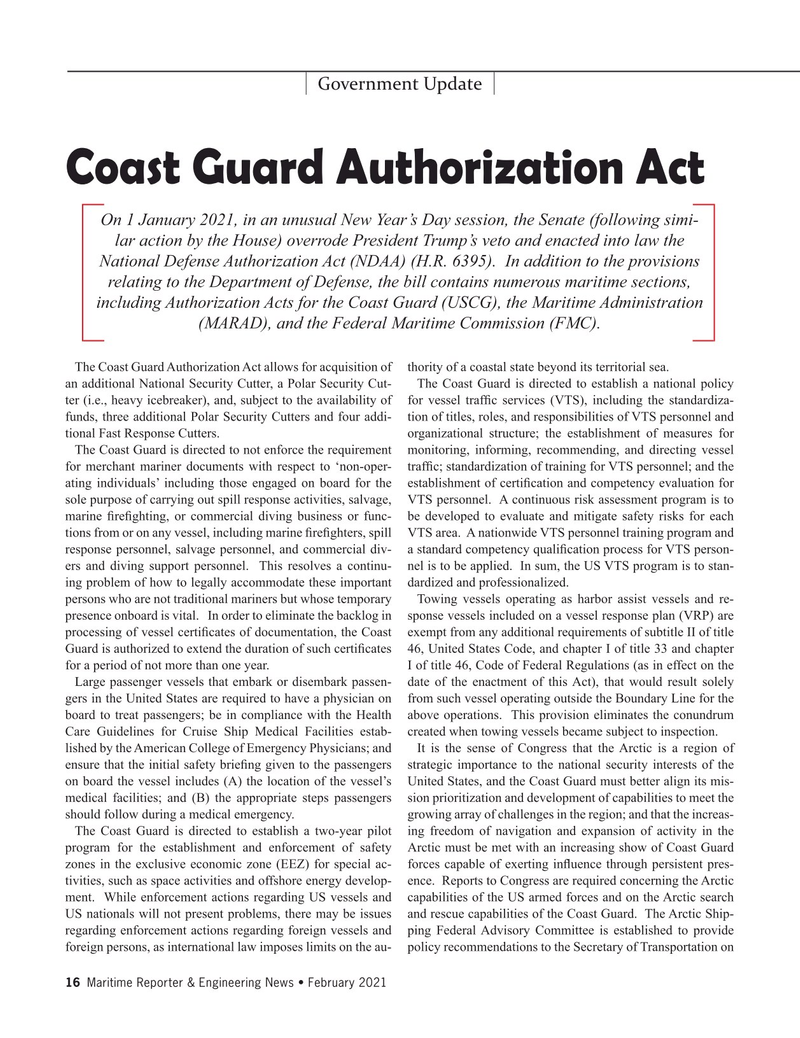
Page 16: of Maritime Reporter Magazine (February 2021)
Government Shipbuilding
Read this page in Pdf, Flash or Html5 edition of February 2021 Maritime Reporter Magazine
Government Update
Coast Guard Authorization Act
On 1 January 2021, in an unusual New Year’s Day session, the Senate (following simi- lar action by the House) overrode President Trump’s veto and enacted into law the
National Defense Authorization Act (NDAA) (H.R. 6395). In addition to the provisions relating to the Department of Defense, the bill contains numerous maritime sections, including Authorization Acts for the Coast Guard (USCG), the Maritime Administration (MARAD), and the Federal Maritime Commission (FMC).
The Coast Guard Authorization Act allows for acquisition of thority of a coastal state beyond its territorial sea. an additional National Security Cutter, a Polar Security Cut- The Coast Guard is directed to establish a national policy ter (i.e., heavy icebreaker), and, subject to the availability of for vessel traf? c services (VTS), including the standardiza- funds, three additional Polar Security Cutters and four addi- tion of titles, roles, and responsibilities of VTS personnel and tional Fast Response Cutters. organizational structure; the establishment of measures for
The Coast Guard is directed to not enforce the requirement monitoring, informing, recommending, and directing vessel for merchant mariner documents with respect to ‘non-oper- traf? c; standardization of training for VTS personnel; and the ating individuals’ including those engaged on board for the establishment of certi? cation and competency evaluation for sole purpose of carrying out spill response activities, salvage, VTS personnel. A continuous risk assessment program is to marine ? re? ghting, or commercial diving business or func- be developed to evaluate and mitigate safety risks for each tions from or on any vessel, including marine ? re? ghters, spill VTS area. A nationwide VTS personnel training program and response personnel, salvage personnel, and commercial div- a standard competency quali? cation process for VTS person- ers and diving support personnel. This resolves a continu- nel is to be applied. In sum, the US VTS program is to stan- ing problem of how to legally accommodate these important dardized and professionalized.
persons who are not traditional mariners but whose temporary Towing vessels operating as harbor assist vessels and re- presence onboard is vital. In order to eliminate the backlog in sponse vessels included on a vessel response plan (VRP) are processing of vessel certi? cates of documentation, the Coast exempt from any additional requirements of subtitle II of title
Guard is authorized to extend the duration of such certi? cates 46, United States Code, and chapter I of title 33 and chapter for a period of not more than one year. I of title 46, Code of Federal Regulations (as in effect on the
Large passenger vessels that embark or disembark passen- date of the enactment of this Act), that would result solely gers in the United States are required to have a physician on from such vessel operating outside the Boundary Line for the board to treat passengers; be in compliance with the Health above operations. This provision eliminates the conundrum
Care Guidelines for Cruise Ship Medical Facilities estab- created when towing vessels became subject to inspection.
lished by the American College of Emergency Physicians; and It is the sense of Congress that the Arctic is a region of ensure that the initial safety brie? ng given to the passengers strategic importance to the national security interests of the on board the vessel includes (A) the location of the vessel’s United States, and the Coast Guard must better align its mis- medical facilities; and (B) the appropriate steps passengers sion prioritization and development of capabilities to meet the should follow during a medical emergency. growing array of challenges in the region; and that the increas-
The Coast Guard is directed to establish a two-year pilot ing freedom of navigation and expansion of activity in the program for the establishment and enforcement of safety Arctic must be met with an increasing show of Coast Guard zones in the exclusive economic zone (EEZ) for special ac- forces capable of exerting in? uence through persistent pres- tivities, such as space activities and offshore energy develop- ence. Reports to Congress are required concerning the Arctic ment. While enforcement actions regarding US vessels and capabilities of the US armed forces and on the Arctic search
US nationals will not present problems, there may be issues and rescue capabilities of the Coast Guard. The Arctic Ship- regarding enforcement actions regarding foreign vessels and ping Federal Advisory Committee is established to provide foreign persons, as international law imposes limits on the au- policy recommendations to the Secretary of Transportation on 16 Maritime Reporter & Engineering News • February 2021
MR #2 (1-17).indd 16 2/4/2021 9:11:34 AM

 15
15

 17
17
